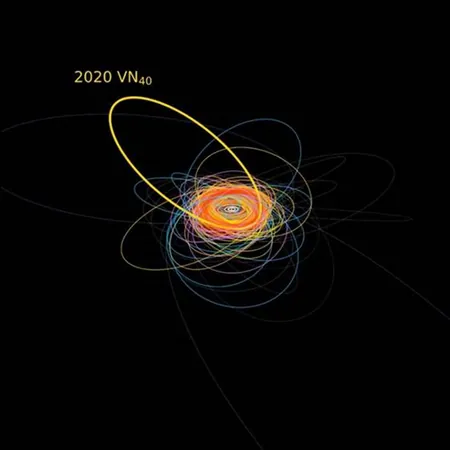
Astronomers Uncover a Distant Mystery in the Outer Solar System
2025-07-07
Author: Michael
Distant Discovery Beyond Neptune
In a groundbreaking revelation, an international team of astronomers, featuring a professor from the University of Regina, has unveiled a rare celestial object lurking far beyond Neptune. Dubbed 2020 VN40, this trans-Neptunian object (TNO) has a unique motion that synchronizes with the orbit of Neptune.
A New Kind of Orbit
The fascinating aspect of 2020 VN40 is that it completes a full orbit around the Sun for every ten orbits that Neptune makes. This unprecedented discovery opens up new avenues for understanding the dynamics of objects residing in the outer solar system.
Dr. Rosemary Pike, the lead researcher from the Center for Astrophysics | Harvard & Smithsonian, emphasized the importance of this discovery, stating, "This is a big step in understanding the outer solar system. It shows that even very distant regions influenced by Neptune can contain objects, offering fresh insights into the solar system's evolution."
Cutting-edge Observations
The discovery emerged from the LiDO (Large Inclination Distant Objects) survey, a project focused on identifying unusual outer solar system objects. Utilizing the Canada-France-Hawaii Telescope as its primary observational tool, the survey also benefits from contributions from the Gemini Observatory and the Magellan Baade Telescope. LiDO specifically seeks out celestial bodies that orbit far above or below the Earth’s orbital plane, regions that have historically been challenging to study.
The Unique Path of 2020 VN40
Orbiting the Sun at an astounding distance of 140 times that of Earth, 2020 VN40 follows an extraordinarily tilted trajectory. Unlike other TNOs, this object's orbit dips below the Solar System's plane, which explains its unusual distance from Neptune even when it approaches the Sun.
Unveiling Secrets of the Solar System
Dr. Samantha Lawler, an associate professor of astronomy at the University of Regina and a key member of the LiDO team, remarked on the marvels of discovering such unique orbital paths among small bodies in the solar system. The alignment of 2020 VN40’s orbit is unprecedented, raising intriguing questions about the mechanisms influencing these distant celestial travelers.
A New Rhythm in Cosmic Movement
Dr. Ruth Murray-Clay from the University of California, Santa Cruz, highlighted the significance of this find with a poetic metaphor: "This new motion is like finding a hidden rhythm in a song we thought we knew. It could change how we think about the way distant objects move." As astronomers continue to explore these far-flung regions, 2020 VN40 serves as a beacon guiding us to deeper understandings of our cosmic neighborhood.









 Brasil (PT)
Brasil (PT)
 Canada (EN)
Canada (EN)
 Chile (ES)
Chile (ES)
 Česko (CS)
Česko (CS)
 대한민국 (KO)
대한민국 (KO)
 España (ES)
España (ES)
 France (FR)
France (FR)
 Hong Kong (EN)
Hong Kong (EN)
 Italia (IT)
Italia (IT)
 日本 (JA)
日本 (JA)
 Magyarország (HU)
Magyarország (HU)
 Norge (NO)
Norge (NO)
 Polska (PL)
Polska (PL)
 Schweiz (DE)
Schweiz (DE)
 Singapore (EN)
Singapore (EN)
 Sverige (SV)
Sverige (SV)
 Suomi (FI)
Suomi (FI)
 Türkiye (TR)
Türkiye (TR)
 الإمارات العربية المتحدة (AR)
الإمارات العربية المتحدة (AR)